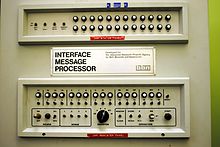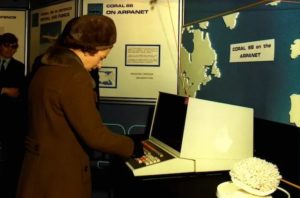We love a good history lesson here at Boomerang. From the first item sold on the Internet (it depends) to Jack’s infamous first tweet when setting up his “twtter”, it’s always fun to look back at where we’ve been and to see the firsts along the way. As email turns 50 years old in 2021, we thought it was time to look back at its history and see where it came from.
So what about that first email? With 300 billion messages sent each week, it’s hard to think that it all started with one, fifty years ago.

Like many pieces of history, the “first” message sent across the Internet depends on who you ask. If we go all the way back to 1969, to the time of ARPANET, we find a message sent between two Interface Message Processors (IMPs). The IMP was sort of the precursor to today’s network router. One of the devices was set up on the UCLA campus, while the other had a home at the Stanford Research Institute. On October 29th, 1969, the first message traveled between them.
But history moves fast, and by 1971 Raymond Tomlinson had a side project. Tomlinson intended to allow people to communicate with each other, rather than relegating messaging to be between computers. He was working on the ARPANET project, and he had a keen interest in messaging across the network.
Until Tomlinson created the “SNDMSG” software, an email consisted of a message that was sent to a numbered mailbox and then had to be printed out. Otherwise, ARPANET programmers relied on using phones to relay messages to one another.
The SNDMSG software allowed two people who were working in different locations to message one another. While we’re all familiar with the “@” symbol dividing a username from an email host, the original intention was to show that someone was quite literally at a different location.
That said, the first message sent between two people over the Internet wasn’t quite as memorable as the first telephone call. Tomlinson says that he doesn’t remember the exact message, because he intended for the message to be forgettable. But he says that it was likely gibberish, perhaps “QWERTYIOP”.
But even that isn’t the whole story. In fact, V.A. Shiva Ayyadurai has his own claim to fame as the inventor of email in 1978. More specifically, Ayyadurai invented an interoffice messaging program that he called “email”. He did the work while he was volunteering at a dental school in New Jersey at a mere 14 years old.
So who developed email? That depends on whether you’re asking about the idea of people messaging each other across computers, or about the specific system called “email” that saw development a few years later.

While the first email messages might not have been memorable, there have been quite a few emails in the fifty-year history that were. For example, the Queen of England sent her first email in 1976. As you might expect, the first spam email wasn’t far behind, dating back to Gary Thurek‘s unsolicited marketing messages from 1978. Gary kicked off a nuisance that now consists of 14.5 billion spam emails each day. Is it any wonder why Inbox Pause is so important?
Over the years, our inbox and compose windows have changed quite a bit too. It wasn’t until 1992 that the invention of MIME made it possible to send images, audio, and video inside of an email. Without MIME, we wouldn’t have features like Suggest Times or Read Receipts today!
Webmail first arrived around 1993, but didn’t become widely popular until 1996. Fast forward to 2004 and Google introduces Gmail to the world on April 1st. The surprise that everyone thought was an April Fool’s joke turned out to be a behemoth in the industry. Today, Gmail owns a whopping 28% of the web-based email market. Suffice it to say, that presence might have had something to do with us building Boomerang for Gmail all the way back in 2010.
In fact, Boomerang is responsible for some firsts of our own in the email history, beginning with the first button to snooze an email all the way back in August of 2010. Since then, almost every major email client (and even many collaborative programs like Slack and Trello) has adopted some way to defer a message.
Things have changed a lot in the past 50 years. Twitter’s co-founder Jack Dorsey’s first ever tweet was sold, as a nonfungible token (NFT), for $2.9 million. The father of spam email is now a respected mind in the world of marketing. And the once-important phone call? There’s a good chance that you barely use your phone for those these days. Of course, email has become so mainstream that it is second nature for most of us.
Today it’s common for the average office worker to send over 100 emails each day, leading to overloaded inboxes, missed connections, and other distractions. For the Boomerang team, this presents endless opportunities to make email work better, allowing you to be more productive.
Curious how your own email behavior adds up? Drop by your Boomerang Insights page to take a look.
